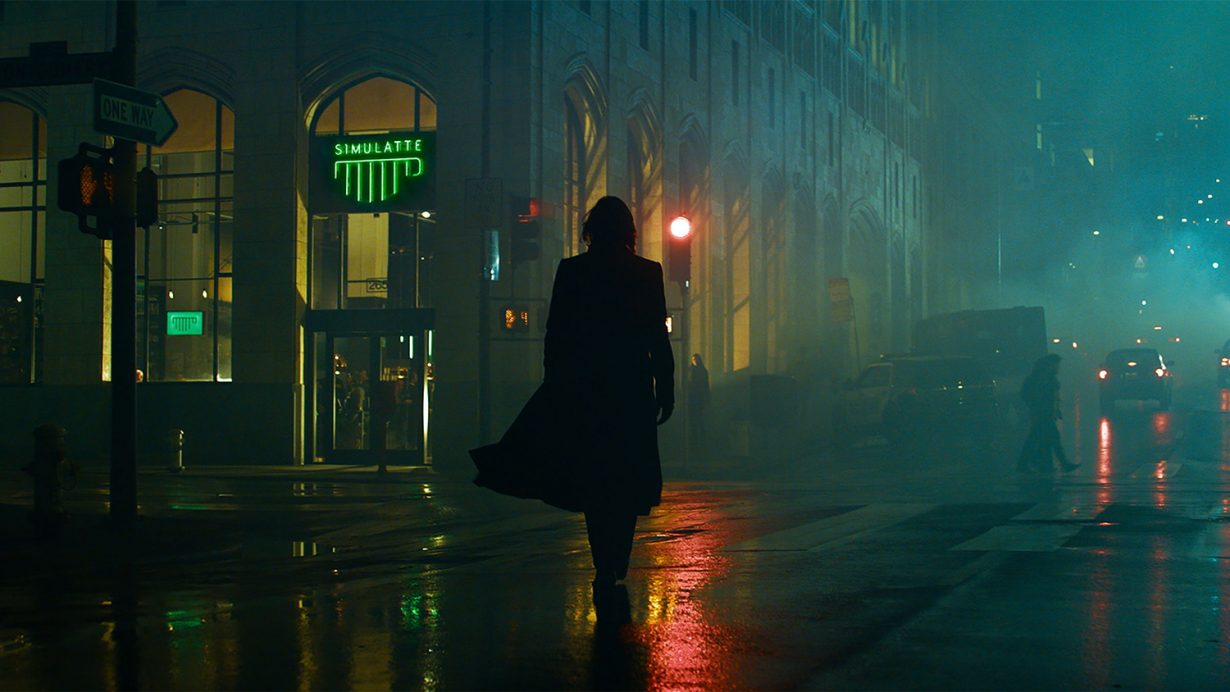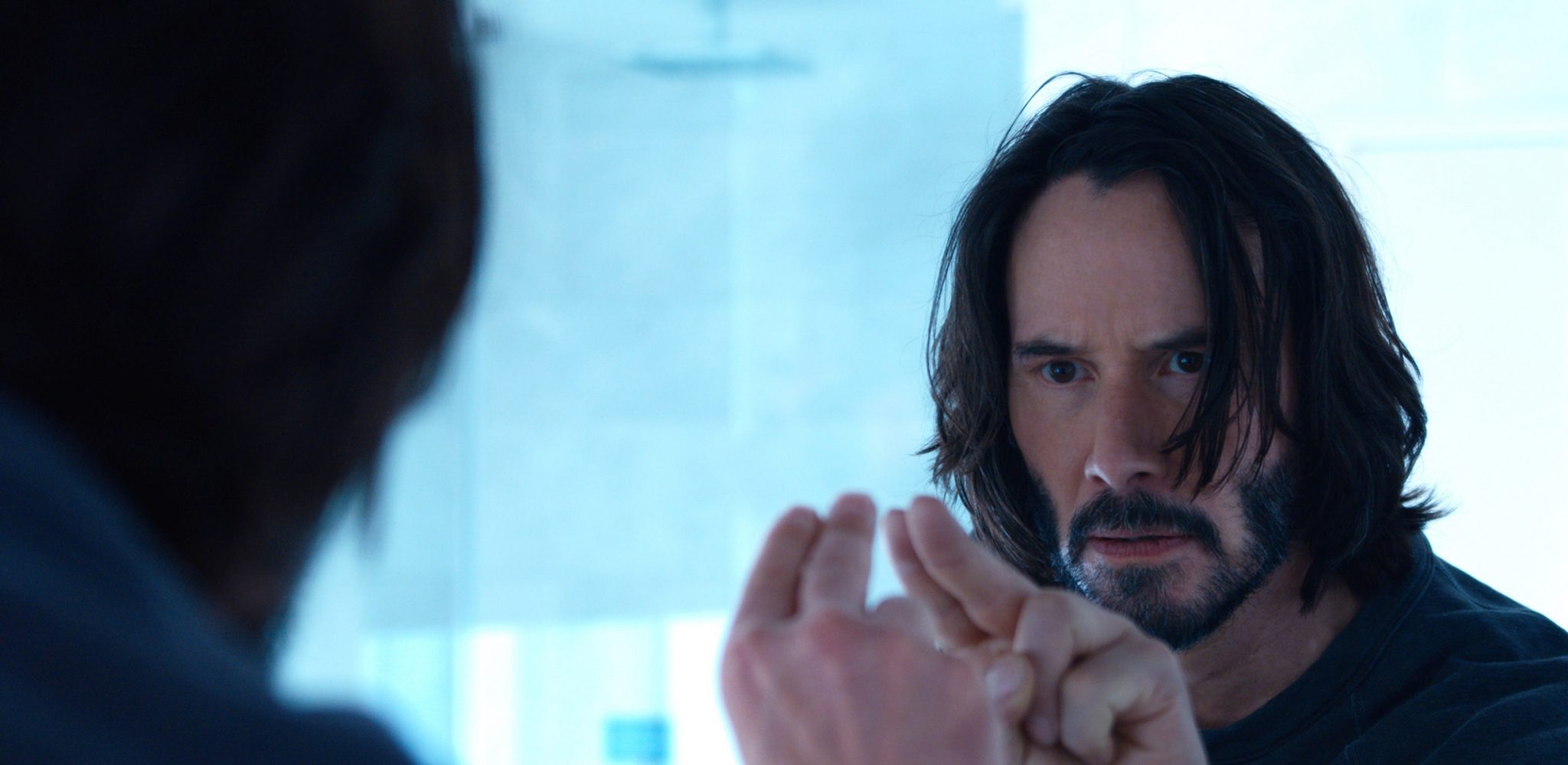Is this something worse?
At the beginning of December, I went to a cinema in London’s Canary Wharf to watch a re-issue of The Matrix (1999). It had been remastered in 4K and when Keanu Reeves clawed through his slime egg, writhing in wires and harsh reality, it felt like his hands were bursting through the screen. It had aged so well, we said afterwards, as we walked through the business district, joking about seeing green numbers cascading down the skyscrapers. Instead of over two decades ago, it seemed as if it could have been released that very day. But then, almost exactly a month later, I went back to the same cinema to watch The Matrix Resurrections (2021), and this feeling was punctured, revealed as pure fantasy. Watching Lana Wachowski’s neo-Neo creation, it is impossible not to realise that, rather than The Matrix (1999) ageing well – still somehow fitting or reflecting contemporary reality – it is contemporary reality that has resisted ageing at all. The original Matrix is, inescapably, a millennial cultural product. But, equally as inescapably it seems, the current cultural moment has been created in its image; cast in its hypercool, cyberpunk, black-leather shadow. It created a visual aesthetic and vocabulary that we can’t seem to outpace. Emerging from The Matrix Resurrections, once again walking through the high-rises of global capital, I realised a month earlier I had been looking at the world through green-tinted glasses, immersed in nostalgia.

How can a reboot, or sequel, or whatever it is this new instalment of the Matrix franchise is, puncture nostalgia, when nostalgia is the lifeblood of Hollywood’s relentless remake culture, and, indeed, of pop culture more broadly, addicted as it is to iterations and imitations of its own past? Well, one way of doing it is by taking all the things that made ‘the original’ iconic, and either exaggerating them into absurdity, or shooting them to shit. Look, let’s get this out of the way now. A lot of people will really dislike The Matrix Resurrections. And that’s because it flips the script on what a reboot should do: stage a new plot, while respecting the established aesthetic pattern. Instead, we have a film which opens with the same scene the first film opened with, with the addition of a character watching the action, muttering “we know what happens next”. More shockingly perhaps, Yuen Woo-Ping’s iconic fight sequences, the iconic dystopian costumes, and the iconic green tint are, for much of the film, relegated to flashbacks. Far from paying respect to the aesthetic that cemented its cult status, in Resurrections, as filmmaker Adam Egypt Mortimer writes, ‘the first trilogy’s shiny-cool aesthetic is continuously and resolutely smashed by its own creator.’ Some will relish the audacity of Wachowski’s approach, recognising the film’s amped up trans-ness and queerness and camp, while others will surely balk at how brazenly she revels in obliterating key aspects of her franchise’s legacy. But, whether Resurrections provokes ecstasy or dismay, to my mind one thing is clear: Wachowski is taking aim at the nostalgia industry, a branch of the culture industry that, just as the Matrix of the first film kept resetting to the start of 1999, keeps relentlessly returning to the past; keeping the public in a backward-looking dream state, distracted from the present. In other words, Wachowski is using this latest instalment of The Matrix franchise to interrogate how The Matrix franchise may have functioned like the Matrix itself.
Of course, Wachowski is not the first to consider the trilogy in this way. When, in 2003, French philosopher Jean Baudrillard was interviewed about how his theories on reality, hyperreality and the virtual had inspired the films, he skewered the line of questioning, suggesting ‘The Matrix is surely the kind of film about the Matrix that the Matrix would have been able to produce.’ So, naturally, in Resurrections – a film self-consciously designed to tackle the seemingly interminable theories surrounding it head-on – this is precisely what the Matrix has done. Or, to be more precise, it is what the Matrix has made Thomas Anderson/Neo do, with the minor alteration that, in this ‘reality’, The Matrix isn’t a film franchise at all, but a videogame series. Here, Thomas Anderson is the mind behind the popular Matrix franchise, and it is he who is pushed into dissociative madness by Warner Bros.’ demand for a fourth game. Yes, this meta joke is a bit on the nose; all of Resurrections is a bit on the nose (a natural consequence of the Wachowskis’ ideas being hijacked by some of the worst people on the internet, perhaps). But, the important point is that Thomas Anderson is no longer an office worker/hacker, but an award-winning game-designer; a cortado drinking tech-bro; a ‘creative’; a supposedly successful neoliberal subject.

Instead of cyber green, his world is now tinted blue. Blue, like the blue pills he is prescribed by the Analyst (Neil Patrick Harris), whose clichéd therapist get-up of thick-rimmed glasses and cardigan are also, surprise surprise, blue. Depression blue. Facebook, sorry, Meta blue. Blue, like almost every action film and thriller since 2000. Christopher Nolan blue. Indeed, the colour tone is so Contemporary Cool, that it’s almost possible to think there’s no visual aesthetic being deployed at all, until you realise you’ve been caught out again. Of course, this new Matrix feels like everything and nothing; like the backdrop of now. Of course, you hunger for the ‘game-changing’ green-tint, and for Thomas Anderson to snap out of it, be less dismally submissive, less beta male and blue. Wachowski’s set you up. Like the Merovingian, an old program who speaks like a Frenchman and behaves like the leader of a powerful crime syndicate, and who turns up in Resurrections bearded, dishevelled and shrieking about how, in the past, “We had grace! We had style!”, the audience is constantly hoodwinked into pining for the old Matrix, and the comforts of a familiar dystopia. Now it seems, to hijack and paraphrase the title of McKenzie Wark’s 2019 book, the Matrix is dead: is this something worse?

The Merovingian’s rant is instructive. His fevered yearning for the days when “originality mattered!” ends with an expletive-filled outburst: “You gave us Face-Zucker-suck and Cock-me-climatey-Wiki-piss-and-shit!” Yes, again, it’s on the nose. But, it is also crucial to Wachowski’s attack on the nostalgia industry. As Grafton Tanner stresses in his recent book The Hours Have Lost Their Clock (2021), ‘the nostalgia industry can turn any decade of nightmares into the ‘good old days’.’ Better the devil you know, right? Drawing on the work of Mark Fisher, Simon Reynolds and Byung-Chul Han to chart the rise and politics of nostalgia in an era ‘knocked out of time’, Tanner suggests that ‘keeping the public in a cosy nostalgic reverie can generate mass amnesia, especially if powerful interests hide from the people the deliberate barbarities that, if found out, might stoke the flames of revolution.’ Sound familiar?
But Resurrections is constantly pulling the rug out from under the audience’s feet, so to speak, and making things distinctly less comfortable and ‘cosy’ (pulling the wires out, perhaps). For example, instead of turning from a torn brocade curtain in a flash of lightning and gothic fantasy, here we have Morpheus emerging from a toilet cubicle in a mustard yellow suit. “At last,” he intones, quoting his predecessor, before making it abundantly clear that’s what he’s doing, and that he, too, recognises his character’s apparent fall from grace. Camping it up by the sinks, he paraphrases one of Marx’s most quoted and misquoted statements, asking a stunned still-not-quite-Neo, “tragedy or farce?” That this is the Resurrections rework of the pill scene – the scene that spawned a million thinkpieces and theses and mutated into the manosphere’s favourite turn of phrase – makes this moment all the more remarkable. Perhaps Wachowski is just telling the alt-right Redditors what she thinks of their ‘red-pilled’ politics (get in the toilet, like), but if red pill or blue pill – reality or simulation – was the question before, this is the question now. Tragedy or farce? What will it be Neo?

Of course, what goes unsaid is that history will repeat. But, to hijack Mark Fisher’s phrase, is there no alternative? As Tanner’s book emphasises, Fisher saw the twenty-first century’s nostalgia boom as symptomatic of the limiting horizons set by neoliberal society, arguing in Capitalist Realism (2009) that our cultural consciousness is increasingly incapable of producing the ‘new’, the ‘now’, and imagining the ‘next’. And perhaps this is Resurrections’ true flaw – inescapable as it may be. In the final scene, when Neo and Trinity finally seem to have regained their cool and got their “mojo back,” the Analyst taunts the duo, imagining what they’ll do now that they can change the world at will: “paint the sky with rainbows?” In possibly the last not-so-coded reference to the franchise’s essential queerness, Trinity quips that this is “not a bad idea.” But, as the designer of this updated, more brutal and more productive Matrix, the Analyst is rapacious neoliberalism writ large, and surely painting his skies with rainbows is like welcoming banks’ rainbow-branded floats at Pride. No other ideas are offered. The duo zip off into the sunset, the credits roll, and the audience is left wondering how they might start changing the world. What other ending could there possibly be, I suppose? Wachowski’s done her bit, now it’s time for the rest of us to imagine something new.
